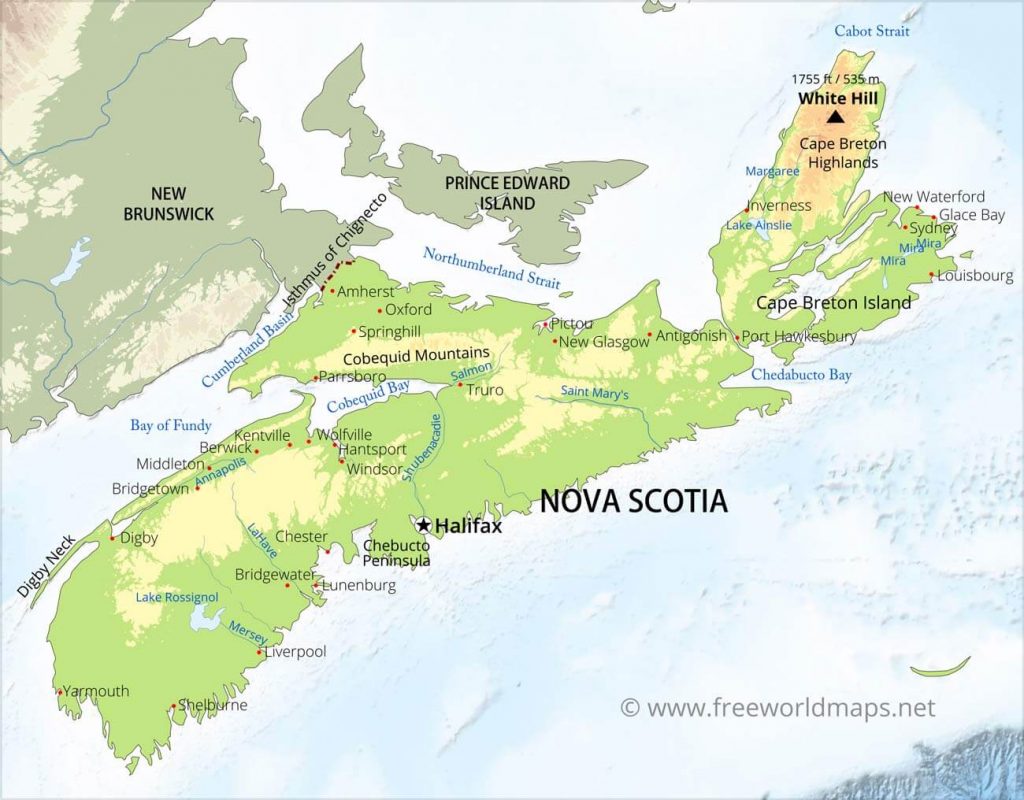What is the weather like in Nova Scotia?

1. Introduction about weather in Nova Scotia
Nova Scotia is a maritime province of south-eastern Canada, extended from parallel 43 to parallel 47 north, and is formed by the peninsula of the same name, which is stretched from the continent, and the island of Cape Breton, which is very close to the same peninsula. Then there are several smaller islands.

We are in an area characterized by the continuous clash of air masses, which makes the climate unstable, windy and rainy (and snowy in winter). Furthermore, fogs are frequent along the coasts, especially the southern one, due to the infiltration of damp air coming from the south (in fact, the Gulf Stream flows not far away).
Precipitation is fairly well distributed throughout the year, and ranges from 1,100 millimeters (43.5 inches) per year on the north coast, to 1,500 mm (59 in) on the south coast, to 2,000 mm (78 in) in the north of Cape Breton island.
Snowfall is abundant: generally, 1 and a half meters (59 in) of snow fall per year on the southern coast, 2 and a half meters (98 in) on the northern one, and up to 4 meters (157 in) in the north of Cape Breton island (see Ingonish). Usually it snows from late November to early April. In winter, snow storms can occur, called “nor’easters” because they are brought by strong winds from the north-east.

In winter, on colder days, the temperature drops to -15 °C (5 °F) even on the coasts, and in colder winters, it can reach lower values. In 1994, the temperature dropped to -29 °C (-20 °F) in Amherst, to -27 °C (-16.5 °F) in Sydney and Halifax, and to -21 °C (-6 °F) in Yarmouth.
In the north, the Northumberland Strait, more closed and exposed to cold sea currents, can freeze in winter.
Since Nova Scotia is exposed to cold currents from the north as well as mild currents from the south, the winter is not always freezing, but is characterized by variations in temperature. So, in winter, in addition to snow, rain can fall, and the temperature can exceed freezing, and can sometimes go up to 10 °C (50 °F).
In summer, temperatures are generally pleasant. Hot days, with highs around 30/32 °C (86/90 °F), are rare.

From July to October, Nova Scotia can be reached from time to time by hurricanes of the Atlantic, which bend towards the north-east after affecting the Caribbean. They are generally weak by the time they reach Nova Scotia because they have to cross a cold sea, however they can still bring abundant rainfall and strong wind. The strongest hurricanes were Ginny in October 1963 and Juan in September 2003.
Nova Scotia is a fairly flat province, although in the interior there are hills, called Highlands, whose highest point is White Hill, 538 meters (1,765 ft) high, located in Cape Breton Highlands National Park, on Cape Breton island. Warm, fohn-like winds can descend from these hills on the west coast of the island (see Chéticamp, Grand Étang).
In the north-west, in the bay of Fundy, there are the highest tides in the world, around 12 meters (40 ft). From mid-July to early September, whales can be observed in the same bay.
2. Weather in different areas
Sydney
Sydney is located in the north, on the northeastern coast of Cape Breton island.
The average temperature of the coldest month (February) is of -5.9 °C (21 °F), that of the warmest month (August) is of 18 °C (64 °F).

Precipitation amounts to 1,515 millimeters (59.6 inches) per year. On average, 283 cm (111 in) of snow fall per year.

On average, there are around 1,815 sunshine hours per year.
Amherst
Amherst is located in the north of the peninsula, near the coast (Chignecto bay, which freezes in winter), and on the border with New Brunswick.
The average temperature of the coldest month (January) is of -7.7 °C (18 °F), that of the warmest month (July) is of 18.5 °C (65 °F).

Precipitation amounts to 1,155 millimeters (45.5 inches) per year. On average, 254 cm (100 in) of snow fall per year.

On average, there are around 1,775 sunshine hours per year.
Halifax
Halifax, the capital, is located on the Atlantic coast.
The average temperature of the coldest month (January) is of -4.2 °C (25 °F), that of the warmest month (August) is of 19.3 °C (67 °F).

Precipitation amounts to 1,450 millimeters (57.1 inches) per year. On average, 154 cm (60.7 in) of snow fall per year.

On average, there are around 1,960 sunshine hours per year.
Yarmouth
Yarmouth is located in the southwest, on the coast of the Gulf of Maine, in the mildest but also foggiest area of the province.
The average temperature of the coldest month (January) is of -3.1 °C (27 °F), that of the warmest month (August) is of 17 °C (63 °F).

Precipitation amounts to 1,295 millimeters (51 inches) per year. In a year, 207 cm (81.5 in) of snow fall.

On average, there are around 1,900 sunshine hours per year.
3. When to go to Nova Scotia
The best time to visit Nova Scotia is from June to September, as it is the mildest of the year. July and August are the warmest months.
Read more: Frequently asked questions about Nova Scotia nominee program







